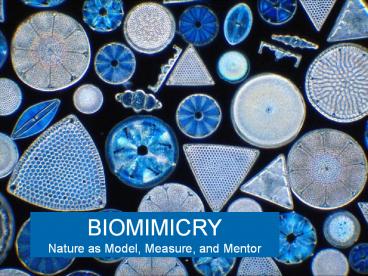BIOMIMICRY - PowerPoint PPT Presentation
1 / 21
Title:
BIOMIMICRY
Description:
Functional Taxonomy. Function is the pivot between life's wisdom and what we ... by similarity so it's called a taxonomy (an organized system of naming) of functions. ... – PowerPoint PPT presentation
Number of Views:428
Avg rating:3.0/5.0
Title: BIOMIMICRY
1
BIOMIMICRY Nature as Model, Measure, and Mentor
2
BI-O-MIM-IC-RY(From the Greek bios, life, and
mimesis, imitation)
- Nature as model. Biomimicry is a new science
that studies Natures models and then imitates or
takes inspiration from these designs and
processes to solve human problems. - Nature as measure. Biomimicry uses an ecological
standard to judge rightness of our innovations. - Nature as mentor. Biomimicry is a new way of
viewing and valuing Nature.
3
Energy Efficiency Learning from Nature how to
create flow without friction. PAX Fans and
Impellers
Design How does Nature attach and detach?
Gecko tape
4
Toxics Learning from plants how to clean
without cleaners The Lotus Effect
5
Architecture Learning from termites how to
create sustainable buildings Passive Climate
Control in the Eastport Building, Harare Zimbabwe
6
Transportation How does Nature travel quickly
and smoothly? The Shinkansen Bullet Train in
Japan
7
- Medicine Learning from Chimpanzees how to heal
ourselves
8
- Human Safety
- Learning from Dolphins how to warn people about
Tsunamis
9
Climate Change Learning from human lungs how
to sequester carbon
10
- Agriculture Learning from prairies how to grow
food sustainably
11
The Biomimicry Guilds Functional Taxonomy
- Function is the pivot between lifes wisdom and
what we - are trying to achieve intentionally.
- What function do you want your design to
perform? - How does life perform that function?
- The Biomimicry Guild has produced an organized
collection of functions that covers everything
that life does and that we might want a design to
do. - The functions are grouped by similarity so its
called a
taxonomy (an organized system of
naming) of functions.
12
Identify the Real Challenge
- Dont ask what do you want to design? (an air
conditioner) - Ask what do you want your design to do? (make
people feel cooler) - Ask why? multiple times (Challenge Air
conditioners use lots of energy because they use
heat to dry desiccants that dehumidify air and
then they must cool the heated air.) - Why use desiccants? (To dry the air)
- Why do the units dry air? (Because high humidity
makes air feel warmer) - Why are they using heat? (To drive the moisture
out of the desiccant so it can be reused) - So, you want a design to pull moisture
- out of air and cool the air!
13
Develop a Design Brief for the Needed Function
- Biologize the Question
- Identify functions (i.e. purpose, role, or use)
- How does Nature do that function?
- How does Nature not do that function?
- Reframe questions with additional keywords.
14
Develop a Design Brief for the Needed Function
- Define Operating Parameters
- Climate conditions (wet, dry, cold,
hot, low/high pressure, highly variable, high/low
UV,etc.) - Nutrient conditions (nutrient poor no ,
nutrient rich lots of available
materials) - Social conditions (competitive, cooperative)
- Temporal conditions (dynamic, static, growing,
ageing) - After defining operating parameters, ask
- How does Nature do that function HERE?
- In these conditions?
15
Integrate Life's Principles into the Design
Brief
- Optimize rather than maximize
- Locally attuned and responsive
- Build in resilience
- Leverage interdependence
- Integrate cyclic processes
- Use benign manufacturing
16
Find The Best Natural Models
- Go for a walk outside
- Consider both literal and metaphorical
- models
- Comb the literature
- Brainstorm with Biologists
17
Identify Deep Patterns and Principles
- Look across discovered strategies
- Look at the strategies collectively
- Specific to your desired function, what does
each strategy have in common? - How are they different?
18
Deepen the Conversation
- Are you mimicking form?
- Can you mimic process?
- Can you mimic the ecosystem?
- Does the design
- create conditions conducive to life?
19
Evaluate your findings
- Can it adapt and evolve?
- Thank your teacher (Nature) for the inspiration
20
Nature as Mentor Incredibly competent
universe Natures living examples Can
live abundantly and enhance where you live
Much older mentors have figured it out
We can do the same thing JANINE BENYUS
21
?? Questions ??
- How can EPA use Biomimicry to meet our mission?
- Where are the leverage points EPA can use to
promote Biomimicry as part of a sustainable
ecosystem approach?































